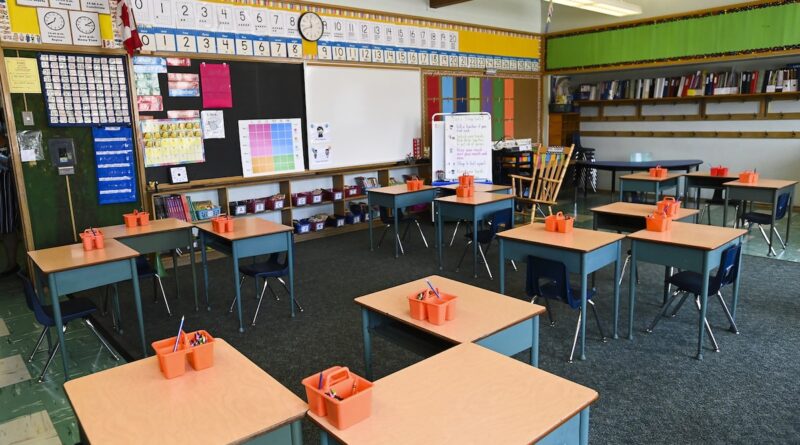Study warns violence in Ontario schools is at ‘crisis levels’ for teachers and education workers

The increase in violence is compounded by the food insecurity many families are facing and other socio-economic stressors. Classroom at Hunter’s Glen Junior Public School in Toronto, on Sept. 14, 2020.Nathan Denette/The Canadian Press
A teacher being pulled by her ponytail over the back of her chair by a student. Students biting, punching and kicking their teachers.
Students threatening their teachers, or using racial and homophobic slurs towards them.
This type of workplace violence in schools across Ontario is now so frequent that it has reached crisis levels, says a new report by researchers from the University of Ottawa released last month.
“There needs to be widespread acknowledgement that schools have changed,” said Chris Bruckert, a criminology professor and one of the study’s authors.
Underfunding, overcrowded classrooms, increasing student needs, lack of supports such as school psychologists and dwindling professional health services are all to blame for the increase, researchers say. The problem is compounded by the food insecurity many families are facing and other socio-economic stressors, according to Darby Mallory, a graduate student and co-author of the report.
“We’ve found ourselves in this time period where all of these really intense things have happened, they’ve accumulated. And at the same time, we’re seeing a decline in funding and an increase in needs. We’re just now hitting a crisis point,” she said.
The report, titled Running on Fumes: Violence, Austerity, and Institutional Neglect in Ontario Schools, is based on a survey of 6,000 Ontario education sector workers regarding their experiences of workplace violence in the 2022-23 school year.
Researchers found that 67 per cent of respondents had experienced at least one act of student-initiated force, and 30 per cent had experienced more than 20 different acts of force during the school year.
As well, 63 per cent of respondents reported a threat of physical force from a student, with 23 per cent reporting being threatened by students at least 20 times during the year.
Previous research conducted by Prof. Bruckert and colleagues shows that student violence is on the rise compared to less than a decade ago.
In a survey conducted in 2018, the researchers found 62 per cent of elementary school teachers had experienced at least one act of student-initiated violence. By 2023, that number had jumped to 95 per cent.
“It‘s really important not to see this as bad kids or demonize kids. This is truly structural violence. This is institutional violence. This is a failure to respond to needs that ends up being enacted like violence,” Prof. Bruckert says.
Many teachers are leaving the profession because of the violence and harassment that they now face on a regular basis, says Heidi Yetman, president of the Canadian Teachers’ Federation, a not-for-profit organization that represents more than 370,000 elementary and secondary school teachers and education workers across the country.
“We have a huge retention and recruitment issue across the country,” she says. “The classroom is not a safe working space.”
Violence in the classroom also affects students’ well-being and ability to learn, Ms. Yetman says.
“Imagine being a student in a classroom that needs to be evacuated once every two weeks because of a specific student,” she says. “It has a great effect on learning. It has a great effect on the psyche of kids.”
Schools lack the resources needed to support students who are having violent outbursts or who are dysregulated, Ms. Yetman says.
“We don’t have enough support staff. We don’t have enough psychologists. We don’t have enough counsellors,” she says.
As violence in schools is on the rise, it is becoming normalized by teachers and students alike who see it as part of being in school, says Karen Littlewood, president of the Ontario Secondary School Teachers’ Federation, a union that represents more than 60,000 teachers and educational workers in the province.
Ms. Littlewood points to signs in doctors’ offices, post offices and so many other places of business that violence, harassment and bullying will not be tolerated.
“But in schools, we’re not supposed to say anything. We’re just supposed to take it and say everything is okay. But it‘s not okay. The kids are not okay, the schools are not okay, the working conditions are not okay,” she says.

